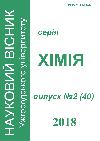ЩОДО ВИЗНАЧЕННЯ КООРДИНАЦІЙНОГО ЧИСЛА В МОДЕЛІ ЗВ’ЯЗКОВОЇ ВАЛЕНТНОСТІ
DOI:
https://doi.org/10.24144/2414-0260.2018.2.17-19Ключові слова:
кристалічна структура, координаційна сфера, модель валентності зв'язкуАнотація
The bond valence model (BVM) in its modern form is widely used in mineralogy and structural inorganic chemistry as a powerful yet convenient tool for validating crystal structures and for predicting interatomic distances in the crystal structures of known chemical composition and presupposed bond network. Bond valence (BV) sAX is defined as the part of the classical atomic valence shared with each A–X cation-anion bond in a given [AXn] coordination sphere. The valence of a bond (measured in valence units, v.u.) is considered to be a unique function of the bond length; and the most commonly adopted empirical expression for the relationship between the bond valences sAX and the bond lengths rAX is the equation sAX = exp[(r0 – rAX)/b], where r0 and b are the empirically determined constants (BV parameters) for a given A/X ion (atom) pair.
The BV parameters r0 and b are typically derived by fitting the above sAX = f(rAX) equation to a representative set of well determined coordination spheres under the constraint that the sums of the sAX values calculated for the central atoms of the considered coordination shells are equal or as close as possible to the oxidation state (atomic valence) expected for these atoms. The BV parameters determined in this way can readily be used for validating newly determined crystal structures via bond valence summation and for predicting bond lengths. Unfortunately, the physical limit of the coordination sphere has presently no the universally adopted definition; so, in calculating the BV parameters, researchers set the limit(s) from their personal opinions and preferences. As a result of the absence of the adopted definition for the limit of the coordination sphere, the BV parameters (r0; b) determined for the same ion pair in different works could be incompatible with each other.
The main goal of this work is to present the rigorous and structure-oriented definition for the limit of the coordination sphere, successfully used by the author over the last decade: the shortest distance from the central cation to another cation in a given crystal structure is taken as the physical limit of the coordination sphere under consideration.Посилання
Pauling L. The Nature of the Chemical Bond. Ithaca: Cornell University Press, 1960. P.644.
Brown I.D. The Chemical Bond in Inorganic Chemistry: The Bond Valence Model. New York: Oxford University Press, 2002. P.288.
Brown I.D. Chem. Rev. 2009, 109(12), 6858-6919.
Brown I.D., Altermatt D. Acta Crystallogr. 1985, B41(4), 244-247.
Brese N.E., O'Keeffe M. Acta Crystallogr. 1991, B47(2), 192-197.
Sidey V. Acta Crystallogr. 2006, B62(5), 949-951.
Holovey V.M., Sidey V.I., Lyamayev V.I., Puga P.P. J. Luminescence. 2007, 126(2), 408-412.
Holovey V.M., Sidey V.I., Lyamayev V.I., Birov M.M. J. Phys. Chem. Solids. 2007, 68(7), 1305-1310.
Sidey V.I., Milyan P.M., Semrad O.O., Solomon A.M. J. Alloys Compd. 2008, 457(1-2), 480-484.
Sidey V. Acta Crystallogr. 2008, B64(4), 515-518.
Sidey V. Acta Crystallogr. 2009, B65(1), 99-101.
Sidey V. Acta Crystallogr. 2009, B65(3) 401-402.
Sidey V. Acta Crystallogr. 2010, B66(3), 307-314.
Sidey V.I., Zubaka O.V., Stercho I.P., Peresh E.Yu. Chem. Met. Alloys. 2010, 3, 108-114.
Sidey V. Acta Crystallogr. 2011, B67(3), 263-265.
Sidey V. Acta Crystallogr. 2012, B68(3), 318-320.
Sidey V. Acta Crystallogr. 2013, B69(1), 86-89.
Sergeeva A., Sidey V. Chem. Met. Alloys. 2013, 6, 1-6.
Sidey V. Chem. Met. Alloys. 2013, 6, 109-112.
Sidey V. Z. Kristallogr. 2013, 228(11), 570-575.
Sidey V. Acta Crystallogr. 2014, B70(3), 608-611.
Sidey V. Acta Crystallogr. 2015, B71(4), 484-487.
Sidey V. Z. Kristallogr. 2015, 230(7), 495-498.
Sidey V. Acta Crystallogr. 2016, B72(4), 626-633.
Sidey V., Shteyfan A. J. Phys. Chem. Solids. 2017, 103, 73-75.
Adams S. Acta Crystallogr. 2001, B57(3), 278-287.
Chen H., Adams S. IUCrJ. 2017, 4(5), 614-625.
Gagné O.C., Hawthorne F.C. Acta Crystallogr. 2015, B71(5), 562-578.
Brown I.D. IUCrJ. 2017, 4(5), 514-515.
Brown I.D. Acta Crystallogr. 1988, B44(6), 545-553.
##submission.downloads##
Номер
Розділ
Ліцензія
Ліцензування
Стаття та будь-який пов’язаний з нею опублікований матеріал поширюється за ліцензією Attribution-NonCommercial 4.0 International (CC BY-NC 4.0)
Умови цієї ліцензії не впливають на права автора чи іншого творчого виконавця захищати цілісність і право власності на свою роботу.
Авторське право на макет журналу та обкладинки повністю належить ДВНЗ "Ужгородський національний університет".
Весь контент публікується добросовісно, і думки, висловлені авторами, є тільки їхніми та не обов’язково відображають точку зору ДВНЗ "Ужгородський національний університет".
Автори надають редакційно-видавничому відділу ДВНЗ "Ужгородський національний університет" ліцензію на публікацію статті та ідентифікують себе як першовидавця.
Авторське право
Авторські права на будь-яку статтю зберігаються за автором(ами).
Публікацію статті мають схвалити всі автори та відповідальні органи інститутів, в яких виконувалося дослідження, якщо такі є.
Автори можуть уповноважити одного зі своїх співавторів діяти від їхнього імені та бути автором-кореспондентом, який відповідає за листування з редакційною командою журналу.
Автори можуть надати будь-якій третій стороні право вільно використовувати статтю за умови зазначення авторів та належного оформлення цитування.

